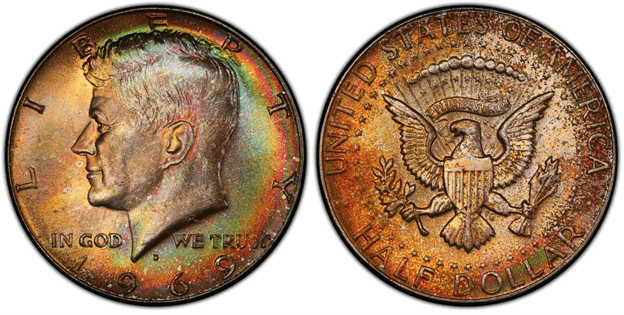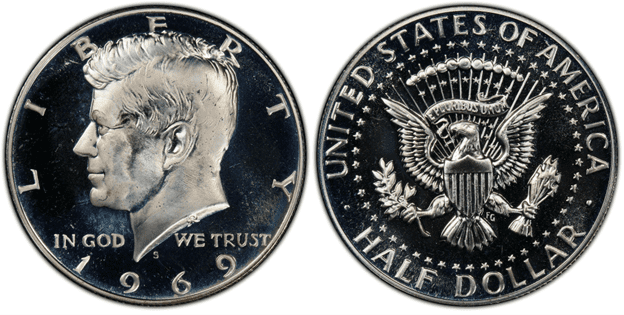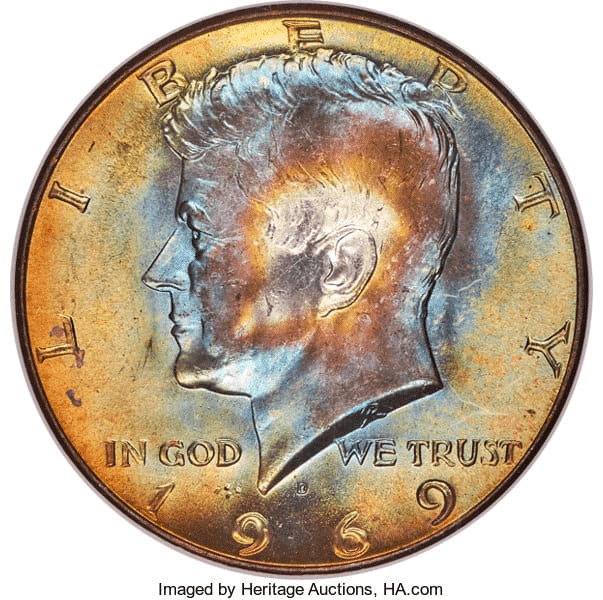What Is The Composition Of A 1969 Kennedy Half Dollar?
The Kennedy half dollar, a fifty-cent coin that was first issued by the United States Mint in 1964, is still manufactured today. It was intended to be a memorial and was approved by Congress a little more than a month after John F. Kennedy, the 35th president of the United States, was killed.
Thanks to the Mint’s utilisation of already finished sculptures by sculptors Gilroy Roberts and Frank Gasparro, the new coins began to be produced in January 1964.
When the silver coins first appeared in March 1964, both collectors and people looking to honour the late president sought them out. The Mint significantly increased output, but the denomination was hardly ever seen in use. As silver’s price increased, more early Kennedy half dollars were accumulated; many of these coins have since been melted for their silver content.
The coin was still prized by collectors even when if the fine silver content was reduced from 90% to 40% (silver clad) starting with coins bearing dates in 1965.
The 1969 Kennedy half dollar was struck in 60% copper with a 40% silver coating because it was produced after 1965. The coin’s obverse face was designed by Gilroy Roberts and has a profile bust of John F. Kennedy, the phrase “LIBERTY,” along the top rim, and the year of mintage beneath his head. On both sides of his neck is written: “IN GOD WE TRUST.”
The reverse face was made by Frank Gasparro and features a large-winged eagle grasping an olive branch in one foot and a bundle of arrows in the other. The phrase “E PLURIBUS UNUM” is displayed on a banner above the eagle’s head, and it is surrounded by a circle of stars.
Along the upper rim, “UNITED STATES OF AMERICA” is printed, and along the lower rim, “HALF DOLLAR.” Despite having undergone a number of special editions and sets, Kennedy half dollars are now primarily produced for collectors.
Neil Armstrong and Edwin “Buzz” Aldrin became the first people to step foot on the moon in 1969 during the American Apollo 11 mission. More than 350,000 rock and roll lovers attend Woodstock, and The Beatles record Abbey Road, their final album as a group.
Is A 1969 Kennedy Half Dollar Silver?
Kennedy half dollars minted in 1969 are 40% silver, having a total of 4.600 grammes or.1479 troy ounces of.999 pure silver.
All Kennedy dollars produced in 1969 contain 40% silver, thus if the coin’s year is 1969, you may be quite certain that it contains silver.
Try looking at the coin’s edge if you want to be absolutely certain. This is where the coin receives the greatest wear, so any cladding is likely to have worn away and exposed any base metal underneath. The coin will have a reddish-brown streak if it includes copper.
Instead, if you can clearly see a silver stripe, you can be certain that your Kennedy half dollar is made of silver.
1969 Half Dollar Varieties
1969 Half Dollar With No Mint Mark
The mint mark, which had been eliminated from coins in an effort to discourage collecting, was reinstated in 1968, meaning that coins from this year onward featured mint marks. There were no Kennedy half dollars created in Philadelphia in 1969, hence there are no examples of this sort of currency produced in 1969 without a mint mark (as Philadelphia never added a mint mark to their coins at this time).
1969 D Half Dollar
Year: 1969
Face Value: $0.50
Composition: 40% silver and 60% copper
Total Weight: 11.50 g
Diameter: 30.6 mm
Thickness: 2.15 mm
Edge: 150 Reeds
Minted in: Denver
Quantity Minted: 129,881,800

photo source: www.pcgs.com
1969 S Half Dollar
Year: 1969
Face Value: $0.50
Composition: 40% silver and 60% copper
Total Weight: 11.50 g
Diameter: 30.6 mm
Thickness: 2.15 mm
Edge: 150 Reeds
Minted in: Denver
Quantity Minted: 2,934,631

photo source: www.pcgs.com
List of errors
There are no widespread errors recognised in the 1969 strike of the Kennedy Half Dollar, meaning that any errors seen will be on a coin by coin basis. However, there are some rare, sort after examples that have sold at auction for top-dollar.
1969-D NGC MS67

photo source: somethingborrowedpdx.com
Denver is where this Kennedy half dollar from 1969 was struck. It was a slab of coins that the NGC has certified as a registry set. It has a grade of MS67*, placing it among the best Denver Kennedy half dollars from 1969.
There are just five of these coins known to exist, and no coins of higher quality have ever been discovered. This is a desired item for the collector trying to assemble a full set. Additionally, it has a characteristic colour. On both sides, concentric circles are formed by the colours yellow, green, blue, and violet.
In June 2019, it was auctioned by specialised auctioneers Heritage Auctions. The total cost, which took the buyer’s premium into account, was $15,600.
How Much Is A 1969 Kennedy Half Dollar Worth Today?
This coin is worth at least its weight in silver in circulating condition. As of September 7, 2022, this coin’s silver melt value is $2.69. This melt value is determined using the spot silver price of $18.20 an ounce as of right now.
Uncirculated Kennedy half dollars make up the majority of the available inventory. These coins were first saved by collectors, hence the majority were never used in commerce. Uncirculated 1969 D half dollars with a grade of MS 63 are valued at about $6. MS 65 uncirculated coins can be purchased for about $30. In PR 65 condition, the 1969 S proof half dollar is valued at about $8.
How Does The Grading System Work?
The Sheldon Scale is used by numismatists to provide a numerical value to coins. The Sheldon Scale goes from poor (P-1) to perfect mint state (P-1) (MS-70). Coins were originally evaluated using words to reflect their condition (Good, Fair, Excellent, Etc.). Unfortunately, coin collectors and dealers had different ideas about what each of these terms represent.
Professional numismatists joined together in the 1970s and established CoinGrading standards. These numismatists now assign grades at key places on the seventy-point scale, using the most regularly utilized numeric points in conjunction with the original adjective grade. The following are the most common coin grades:
-
-
- (P-1) Poor – Indistinguishable and probably damaged; if used, must have a date and mintmark; otherwise, rather battered.
- (FR-2) Fair – Nearly smooth, but without the damage that a coin graded Poor often possesses. The coin must have enough detail to be identified.
- (G-4) Fair – Inscriptions have merged into the rims in some areas, and important elements have been mostly erased.
- (VG-8) Very Good- A little weathered, but all of the primary design elements are visible, albeit faintly. There is little if any, central detail left.
- (F-12) Good – The item is very worn, yet the wear is even, and the overall design details stand out clearly. Rims are almost completely isolated from the field.
- (VF-20) Very Fine – Moderately weathered, with some finer features still visible. The motto or all letters of LIBERTY are readable. Both sides of the coin have entire rims that are separated from the field.
- (EF-40) Extremely Fine – Gently used; all gadgets are visible, and the most important ones are bold. The finer details are bold and clear, however, light wear may be seen.
- (AU-50) Uncirculated – Slight evidence of wear on the coin’s design’s high points; may have contact marks; eye appeal should be adequate.
- (AU-58) Uncirculated Choice – Slight traces of wear, no severe contact marks, almost full mint shine, and great eye appeal.
- (MS-60) Mint State Basal – Strictly uncirculated; no indication of wear on the coin’s highest points, but an unsightly coin with reduced luster, visible contact marks, hairlines, and other flaws.
- (MS-63) Mint State Acceptable – Uncirculated, but with contact scratches and nicks, little reduced shine, but otherwise appealing appearance. The strike is weak to average.
- (MS-65) Mint State Choice – Uncirculated with great mint shine, very little contact blemishes, and exceptional eye appeal. The strike is unusually severe.
- (MS-68) Mint State Premium Quality – Uncirculated with superb luster, no obvious contact marks to the naked eye, and exceptional eye appeal. The strike is quick and appealing.
- (MS-69) Almost Perfect Mint State – Uncirculated with perfect brilliance, a sharp and appealing strike, and extremely good eye appeal. A near-perfect coin with minor imperfections in the planchet, strike, and contact markings (seen only under 8x magnification).
- (MS-70) Mint State Perfect – Under 8x magnification, there are no tiny imperfections discernible; the strike is crisp, and the coin is perfectly centered on a beautiful planchet. Rarely seen on a coin, this coin is bright and whole, with original luster and exceptional eye appeal.
-
Where To Buy Or Sell 1969 Half Dollars?
Due to the tiny number of rare or extraordinary pieces found in this mintage year, the majority examples of 1969 Half Dollars can be bought and traded on internet marketplaces. Only if you think your coin has exceptional qualities should you consider visiting specialty shops, auctions, or dealers such as Heritage Auctions.
If you’re unclear of the rarity of your 1969 half dollar, coin collecting websites like the U.S. Coin Forum are a wonderful location to ask questions. To grade your coin, services like PCGS are advised.
FAQs
Where is the mint mark on a 1969 Kennedy half dollar?
The mint mark on the Kennedy half dollar is found on the obverse side of of the coin just below Kennedys neck.
What is the value of 40% silver half dollar?
This coin is worth at least its weight in silver in circulating condition. As of September 7, 2022, this coin’s silver melt value is $2.69. This melt value is determined using the spot silver price of $18.20 an ounce as of right now.
What makes a 1969 half dollar rare?
There aren’t any stand out features that make the 1969 half dollar especially rare, but the 40% silver content makes this coin a nice find and means its intrinsic metal value is higher than its face value. Rarer examples of this coin will be those with errors, or those in an exceptional condition such as cameo and deep cameo examples.



